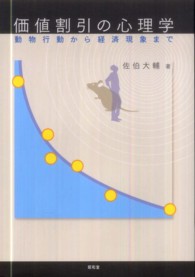基本説明
Drawing on a vast array of work from neuroscience to classroom observation, this book provides a comprehensive picture of what we know about teaching and learning science from kindergarten through eighth grade.
Full Description
What is science for a child? How do children learn about science and how to do science? Drawing on a vast array of work from neuroscience to classroom observation, Taking Science to School provides a comprehensive picture of what we know about teaching and learning science from kindergarten through eighth grade. By looking at a broad range of questions, this book provides a basic foundation for guiding science teaching and supporting students in their learning. Taking Science to School answers such questions as:
When do children begin to learn about science? Are there critical stages in a child's development of such scientific concepts as mass or animate objects?
What role does nonschool learning play in children's knowledge of science?
How can science education capitalize on children's natural curiosity?
What are the best tasks for books, lectures, and hands-on learning?
How can teachers be taught to teach science?
The book also provides a detailed examination of how we know what we know about children's learning of science—about the role of research and evidence. This book will be an essential resource for everyone involved in K-8 science education—teachers, principals, boards of education, teacher education providers and accreditors, education researchers, federal education agencies, and state and federal policy makers. It will also be a useful guide for parents and others interested in how children learn.
Table of Contents
Front Matter
Executive Summary
Part I - Introduction: 1 Science Learning Past and Present
2 Goals for Science Education
Part II - How Children Learn Science: 3 Foundations for Science Learning in Young Children
4 Knowledge and Understanding of the Natural World
5 Generating and Evaluating Scientific Evidence and Explanations
6 Understanding How Scientific Knowledge Is Constructed
7 Participation in Scientific Practices and Discourse
Part III - Supporting Science Learning: 8 Learning Progressions
9 Teaching Science as Practice
10 Supporting Science Instruction
Part IV - Future Directions for Policy, Practice, and Research: 11 Conclusions and Recommendations
Appendix A: Overview of Learning Progressions for Matter and the Atomic-Molecular Theory
Appendix B: Biographical Sketches of Committee Members and Staff
Index
Contents
1 Front Matter; 2 Executive Summary; 3 Part I - Introduction: 1 Science Learning Past and Present; 4 2 Goals for Science Education; 5 Part II - How Children Learn Science: 3 Foundations for Science Learning in Young Children; 6 4 Knowledge and Understanding of the Natural World; 7 5 Generating and Evaluating Scientific Evidence and Explanations; 8 6 Understanding How Scientific Knowledge Is Constructed; 9 7 Participation in Scientific Practices and Discourse; 10 Part III - Supporting Science Learning: 8 Learning Progressions; 11 9 Teaching Science as Practice; 12 10 Supporting Science Instruction; 13 Part IV - Future Directions for Policy, Practice, and Research: 11 Conclusions and Recommendations; 14 Appendix A: Overview of Learning Progressions for Matter and the Atomic-Molecular Theory; 15 Appendix B: Biographical Sketches of Committee Members and Staff; 16 Index




